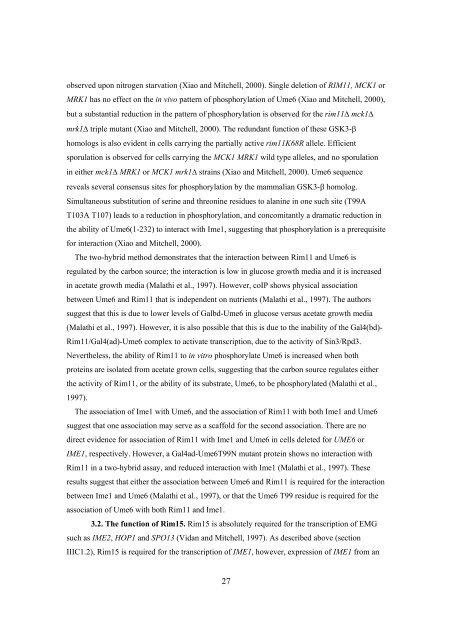Transcriptional regulation of meiosis in budding yeast
Transcriptional regulation of meiosis in budding yeast
Transcriptional regulation of meiosis in budding yeast
You also want an ePaper? Increase the reach of your titles
YUMPU automatically turns print PDFs into web optimized ePapers that Google loves.
observed upon nitrogen starvation (Xiao and Mitchell, 2000). S<strong>in</strong>gle deletion <strong>of</strong> RIM11, MCK1 or<br />
MRK1 has no effect on the <strong>in</strong> vivo pattern <strong>of</strong> phosphorylation <strong>of</strong> Ume6 (Xiao and Mitchell, 2000),<br />
but a substantial reduction <strong>in</strong> the pattern <strong>of</strong> phosphorylation is observed for the rim11∆ mck1∆<br />
mrk1∆ triple mutant (Xiao and Mitchell, 2000). The redundant function <strong>of</strong> these GSK3-β<br />
homologs is also evident <strong>in</strong> cells carry<strong>in</strong>g the partially active rim11K68R allele. Efficient<br />
sporulation is observed for cells carry<strong>in</strong>g the MCK1 MRK1 wild type alleles, and no sporulation<br />
<strong>in</strong> either mck1∆ MRK1 or MCK1 mrk1∆ stra<strong>in</strong>s (Xiao and Mitchell, 2000). Ume6 sequence<br />
reveals several consensus sites for phosphorylation by the mammalian GSK3-β homolog.<br />
Simultaneous substitution <strong>of</strong> ser<strong>in</strong>e and threon<strong>in</strong>e residues to alan<strong>in</strong>e <strong>in</strong> one such site (T99A<br />
T103A T107) leads to a reduction <strong>in</strong> phosphorylation, and concomitantly a dramatic reduction <strong>in</strong><br />
the ability <strong>of</strong> Ume6(1-232) to <strong>in</strong>teract with Ime1, suggest<strong>in</strong>g that phosphorylation is a prerequisite<br />
for <strong>in</strong>teraction (Xiao and Mitchell, 2000).<br />
The two-hybrid method demonstrates that the <strong>in</strong>teraction between Rim11 and Ume6 is<br />
regulated by the carbon source; the <strong>in</strong>teraction is low <strong>in</strong> glucose growth media and it is <strong>in</strong>creased<br />
<strong>in</strong> acetate growth media (Malathi et al., 1997). However, coIP shows physical association<br />
between Ume6 and Rim11 that is <strong>in</strong>dependent on nutrients (Malathi et al., 1997). The authors<br />
suggest that this is due to lower levels <strong>of</strong> Galbd-Ume6 <strong>in</strong> glucose versus acetate growth media<br />
(Malathi et al., 1997). However, it is also possible that this is due to the <strong>in</strong>ability <strong>of</strong> the Gal4(bd)-<br />
Rim11/Gal4(ad)-Ume6 complex to activate transcription, due to the activity <strong>of</strong> S<strong>in</strong>3/Rpd3.<br />
Nevertheless, the ability <strong>of</strong> Rim11 to <strong>in</strong> vitro phosphorylate Ume6 is <strong>in</strong>creased when both<br />
prote<strong>in</strong>s are isolated from acetate grown cells, suggest<strong>in</strong>g that the carbon source regulates either<br />
the activity <strong>of</strong> Rim11, or the ability <strong>of</strong> its substrate, Ume6, to be phosphorylated (Malathi et al.,<br />
1997).<br />
The association <strong>of</strong> Ime1 with Ume6, and the association <strong>of</strong> Rim11 with both Ime1 and Ume6<br />
suggest that one association may serve as a scaffold for the second association. There are no<br />
direct evidence for association <strong>of</strong> Rim11 with Ime1 and Ume6 <strong>in</strong> cells deleted for UME6 or<br />
IME1, respectively. However, a Gal4ad-Ume6T99N mutant prote<strong>in</strong> shows no <strong>in</strong>teraction with<br />
Rim11 <strong>in</strong> a two-hybrid assay, and reduced <strong>in</strong>teraction with Ime1 (Malathi et al., 1997). These<br />
results suggest that either the association between Ume6 and Rim11 is required for the <strong>in</strong>teraction<br />
between Ime1 and Ume6 (Malathi et al., 1997), or that the Ume6 T99 residue is required for the<br />
association <strong>of</strong> Ume6 with both Rim11 and Ime1.<br />
3.2. The function <strong>of</strong> Rim15. Rim15 is absolutely required for the transcription <strong>of</strong> EMG<br />
such as IME2, HOP1 and SPO13 (Vidan and Mitchell, 1997). As described above (section<br />
IIIC1.2), Rim15 is required for the transcription <strong>of</strong> IME1, however, expression <strong>of</strong> IME1 from an<br />
27













